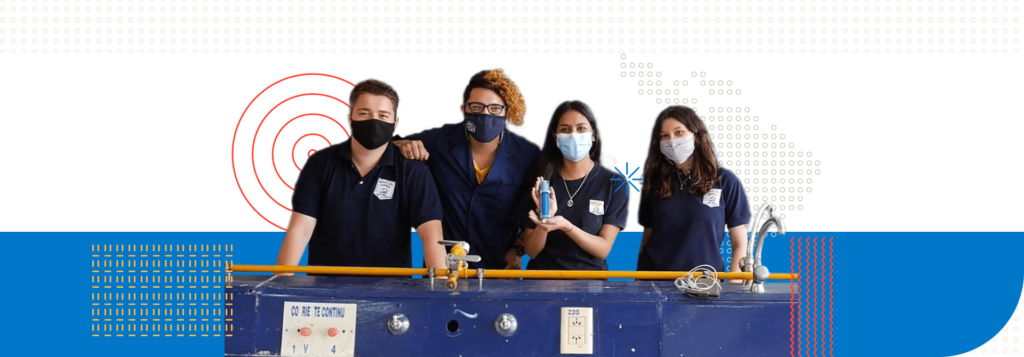In La Mojana region, Colombian Caribbean, 12% of the rice consumed in the country is produced and each year this production generates around 17 thousand tons of rice husk. When disposed improperly, this waste can contaminate bodies of water or the air when incinerated outdoors How can we reduce the environmental pollution caused by this production chain? A team of four students found the answer using it for making a rural construction material.
The innovation titled “Aprovechamiento de la cáscara de arroz” (“Using Rice Husk”, in English) was a finalist in Solve for Tomorrow in Colombia 2022. The group created a prototype that transformed rice husk into a sustainable artisanal construction material (known as bareque or bahareque). The students were between 15 and 17 years old and were in 10th and 11th grade at the time of their participation.
O professor mediador, Dario Vergara, explica que La Mojana tem uma cultura considerada “anfíbia”, porque os agricultores vivem da pesca na época das chuvas e no verão cultivam arroz e mandioca. Ele leciona Física e Ciências Naturais na Instituição Educacional San Marcos e está envolvido na iniciativa da escola chamada “AgroAnfibia”, que reúne diversos professores e alunos de diversas gerações para desenvolver projetos relacionados à realidade local.
The mediator teacher, Dario Vergara, explains that La Mojana has a culture considered “amphibious” because the farmers live from fishing during the rainy season and in the summer they grow rice and yuca (manioc). He teaches Physics and Natural Sciences at the San Marcos Educational Institution and is involved in the school initiative called “AgroAnfibia”, which brings together several teachers and students from various generations to develop projects related to the local reality.
This group then thought of taking advantage of rice husks while preserving the architectural culture, opting to make a new formula for bareques, traditionally made with sticks or reeds along with mud. The students went to investigate the preference for bareques and consulted the population that lives in this area, to share their knowledge and experience. “We asked why brick houses are not built in this area and they told us that when there are floods, brick is not as flexible as bareques,” recalls the educator.
According to residents, the handmade material also provides a more balanced thermal sensation inside the house, compared to the variation in cold or hot outside. It is also a more economical and affordable option for the area, where access to roads is difficult; therefore, it is expensive to bring bricks. Using rice husks has another advantage: a house surrounded by this material repels mosquitoes, which are so present in the region because it is surrounded by swamps, and marshy areas covered in silt.
The students looked for natural and easy-to-obtain materials. They mixed rice husk with a plant considered a pest, the water hyacinth. Additionally, they added cattle manure and sand. They made several types of combinations with these materials and placed them on a palm leaf, forming small squares of less than 1m², which were then dried and left outdoors for testing.
The total cost was only 15 thousand Colombian pesos per m² (over 4 US dollars), including the labor of the person who plastered the house. The rice husk was donated by millers that the students already knew.
In addition to manual processes, the team used Arduino to automate some processes, such as measuring the humidity and temperature of the mixtures.
It is important to show students that it is possible to progress with the tools available in the community and to value traditional knowledge, says Vergara.
The project developed students’ soft skills
Besides the result of the prototype, Vergara mentions that the production of the video was an important exercise to combat shyness and improve communication. He also believes that the experience of defending their project in front of an audience was important for the students to be able to reach university because there they learned to work under pressure. Another challenge they learned to overcome was finding the necessary material and for that the support of the families was fundamental. During each stage, they got involved, helped show the way, and supported the students, the teacher emphasized.
He also notes that each student had other personal benefits. “One of them has a shop in his house where he sells rice and he tells me that he liked learning more about the rice chain. Another student learned a lot from preparing the pitch and that skill helped her in other academic events,” he exemplifies.
The attitude of the other students at the school has also changed. “Before, it was difficult to find students to work on research. After we had this result, the call for applications the following year suddenly brought 30 candidates,” he says proudly. Now, the project to use rice husks continues to develop, with a new group of students.




